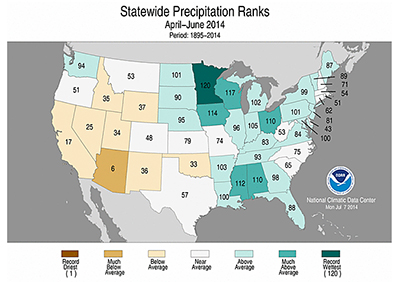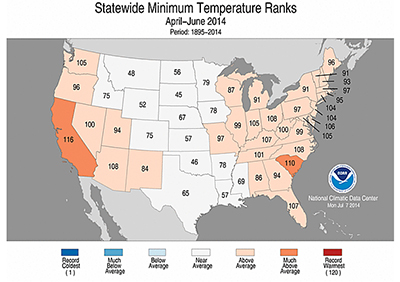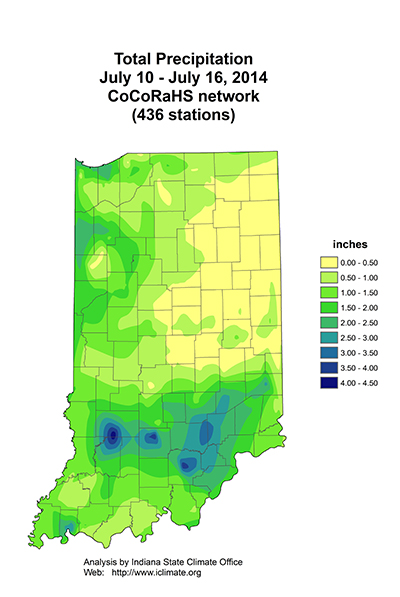USDA-NIFA Extension IPM Grant
Pest & Crop Newsletter, Entomology Extension, Purdue University
- Western Bean Cutworm Flight Picking Up
- VIDEO: Western Bean Cutworm Egg Masses and Young Larvae, Pre-Tassel Corn
- VIDEO: Scouting Western Bean Cutworm Post-Whorl Corn
- 2014 Corn Earworm Trap Report
- Western Bean Cutworm Adult Pheromone Trap Report
Western Bean Cutworm Flight Picking Up - (Christian Krupke and John Obermeyer)
• Moth counts increasing this week.
• Egg laying and egg hatch is occurring.
• Scout for egg masses and hatched larvae ASAP in high-risk fields.
The western bean cutworm (WBC) trapping season continues, view the general increase in numbers from previous weeks (“Western Bean Cutworm Adult Pheromone Trap Report”). Not too surprising that many counts are surging – last week’s warm temperatures along with rains helped pupae finish off development and emerge from the soil. Evidently, the extremely cold winter did not put a huge dent in populations. Currently, clear nights with light breezes are absolutely perfect for moth flight, mate-finding and egg-laying.
A large percentage of this year’s eggs will be laid over the next 2 weeks. Use this year’s trap catches (see following trap report) and recent history as your guide for prioritizing scouting areas. As you view the trap report, notice the variability of moth captures, even within close proximity of each other. Although the relationship between trap catches and damage is not particularly strong (i.e., high trap counts does not mean high damage), traps are a good timing mechanism and presence/absence indicator. When they spike suddenly, it’s time to scout. A larger number should be prioritized for scouting over a smaller one. But that’s about as far as we can take trap counts in assessing damage potential. Areas/fields with damage last year will likely be at most risk this year, but damage will spread to adjacent counties to the south and east of the state’s northwestern “hot zone” for WBC.
Many Bt corn hybrids offer excellent control of WBC and will not require scouting for foliar insecticide treatment. However, some Bt hybrids do not offer any protection, as well as specialty corn, e.g., popcorn, high-oil, etc. Scouting is straightforward - a matter of walking fields and looking for egg masses, generally laid on the top surface of the plant’s upper, most upright leaves. Concentrate your efforts on pre-tassel corn, this growth stage is preferred by female moths as the young larvae initially feed on pollen. If 5% or more of plants surveyed have egg masses, treatment is advised. If needed, early insecticide applications are better than late ones – pyrethroid insecticides will offer enough residual activity in most cases for a few days of killing the tiny newly hatched larvae as they travel on their way into the plant’s whorl or leaf axils. They are very easily killed at that early stage, but once they get inside the whorl/ear of the plant they cannot be contacted with insecticides, so get them early. Happy Scouting!
![]()
VIDEO: Western Bean Cutworm Egg Masses and Young Larvae, Pre-Tassel Corn - (Christian Krupke and John Obermeyer) -
Female western bean cutworm moths prefer egg laying on pre-tassel corn, on the plant’s upper most leaves. This video shows the egg masses and early hatched larvae, and the most likely areas of the plant you are to find them. Only high-risk, not trait-protected, corn should be scouted and assessed for infestation and potential damage to the ears.
VIDEO: Western Bean Cutworm Egg Masses and Young Larvae, Pre-Tassel Corn
![]()
VIDEO: Scouting Western Bean Cutworm Post-Whorl Corn - (Christian Krupke and John Obermeyer) -
Scouting for western bean cutworm egg masses and hatched larvae is difficult and time-consuming once corn is/or has pollinated. This video presents some scouting techniques and considertions in high-risk corn where significant moth captures have occurred.
VIDEO: Scouting Western Bean Cutworm Post-Whorl Corn
![]()
Click here to see the 2014 Corn Earworm Trap Report
![]()
class="bodylink">Western Bean Cutworm Adult Pheromone Trap Report
![]()
Prospects for the 2014 Indiana Corn Crop – (Bob Nielsen) -
pros·pect
/?präs?pekt/
noun (plural: prospects)
1. The possibility or likelihood of some future event occurring.
Seems like everywhere you turn, the “word in the street” is that the prospects for the 2014 Indiana corn crop are nothing short of the moon. Coffee shops and farm shops are abuzz with talk of the prospects of high yields. Farm magazine Web sites, chat rooms, blogs, Twitter feeds, and Facebook pages are alive with the prospects of the 2014 corn crop throughout the Midwest, not just in Indiana. The Chicago Board of Trade and the grain marketing trade obviously believe in the prospects for a bumper crop nationwide.
The immortal Yogi Berra once said, “You can observe a lot by just watching.” I agree that many fields I have walked in recent weeks around the state look as good as I have seen in a long time............. at least since this time last year. It is also true that I have seen fields in recent weeks that look as bad as I have seen in a long time........... at least since this time last year. As an agronomist, I certainly agree with Yogi Berra who also said, “It ain’t over till it’s over.”
The “upside” for some of the 2014 Indiana corn crop is that stand establishment was pretty good, there has been no shortage of rainfall to date (for most of us), temperatures have been moderate to date, disease pressure has been low to date, and the weather forecast for much of the pollination period looks favorable.The “downside” for some of the 2014 Indiana corn crop is that planting was significantly delayed due to frequent spring rainfall, stand establishment was terrible in some fields and required one or more replantings to “get it right”, and subsequent rainfall has been excessive causing significant root death/damage, plant mortality, overall stunting of the crop and significant loss of soil nitrate-nitrogen.
It is true that the estimates of crop condition statewide published by USDA-NASS are currently quite good (75% good or excellent as of 13 July). When compared to crop conditions in recent years where statewide yields were significantly above trend (2001, 2004, 2009, and 2013), the prospects for a good corn crop in 2014 certainly look promising (Fig. 1)................... as long as growing conditions for the remainder of the growing season continue to be favorable.
There are those who question the accuracy of the weekly USDA-NASS crop condition ratings, but there are in fact reasonably accurate historical relationships between those estimates of crop condition ratings and eventual percent departures from trend yield, especially as the season progresses (i.e., as the “target” gets closer). In fact, if the current crop condition ratings (75% good to excellent) remain steady through September, the historical relationship suggests that this year’s Indiana corn crop could yield as much as 8% above the 2014 trend yield or approximately 178 bu/ac. By comparison, the 2013 Indiana corn crop, in another overall good growing season, yielded 177 bu/ac or 7.7% above the 2013 trend yield estimate AND had a higher crop condition rating (80% good or excellent) at this same time in July last year.
Percent of Indiana Corn Crop Rated Good to Excellent 2014 Compared to Recent Years with Good Yields
Ifs, Ands, And Buts...
Yes, the corn crop in Indiana looks good at this point in time. Yes, the prospects for good yields this year are promising. But........... the crop has only “rounded second base” on its way to “home plate”. By this I mean that almost half of the growing season remains ahead of this crop.
If Mother Nature’s “spigot” would turn off and soils rapidly dry to excessively low levels, much of this crop that is likely shallow-rooted due to the early wet season would suffer quickly. Conditions recently have been conducive for the development of foliar diseases, but time will tell whether they will “explode” or not over the coming weeks. The absence of wide-spread nitrogen (N) deficiency symptoms is curious given the excess of rainfall in many areas, but the question lingers whether N deficiency may yet appear during the grain fill period and limit kernel weight. Any severe stress during the grain fill period that limits photosynthesis will encourage corn plants to remobilize stored carbohydrates from the lower stalk tissue to the developing kernels. Such “cannibalization” of lower stalk tissue predisposes the plant to root or stalk rot disease development, leading to weaker stalks and higher risks of stalk breakage or lodging prior to harvest. Such severe photosynthetic stresses include foliar disease, nutrient deficiency, hail damage, and drought stress.
Another old saying seems appropriate at this point in the 2014 growing season, “The opera ain’t over until the fat lady sings.” (journalist Ralph Carpenter, 1976).
Related Reading
USDA-NASS. 2014. Crop Progress (14 July). USDA, National Ag. Statistics Service. <http://usda.mannlib.cornell.edu/usda/nass/CropProg//2010s/2014/CropProg-07-14-2014.pdf> [URL accessed 15 July 2014].
USDA-NASS. 2014. Index to Crop Progress Reports. USDA, National Ag. Statistics Service. <http://usda.mannlib.cornell.edu/MannUsda/viewDocumentInfo.do?documentID=1048> [URL accessed 15 July 2014].
![]()
Weather Outlook by NOAA/NWS - (Jim Noel, NOAA/NWS/Ohio River Forecast Center) -
It was a wet April to June period in Indiana with slightly above normal temperatures.
However, it did not rank in the top 10.
After near record to record cool conditions the week of July 21, the outlook for the remainder of July calls for temperatures to return to above normal levels by July 28 and beyond with rainfall slightly below normal. The majority of the warmth will be in night-time lows versus day-time highs.
After a cooler July, August looks warmer and drier than June or July but still only about normal for both temperatures and rainfall.
Autumn outlook is still looking a little cooler and wetter than normal. The wetter conditions could impact harvest.
Early indications are winter starts colder and wetter and ends warmer and drier which would be opposite recent winters.
You can stay on top of the NWS Ohio River Forecast Center monthly and seasonal hydrologic outlooks at: <http://www.erh.noaa.gov/ohrfc/WRO.shtml>.
![]()






